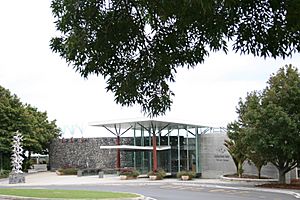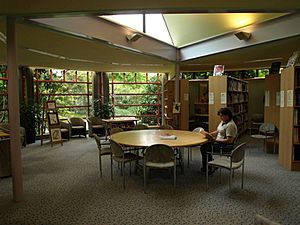Auckland Botanic Gardens facts for kids
The Auckland Botanic Gardens is a huge 64-hectare plant paradise in Manurewa, South Auckland, New Zealand. It's owned by the Auckland Council. The land for the gardens was first bought in 1968. Work on the gardens began in 1973. The gardens officially opened to the public in 1982. Today, they are home to more than 10,000 different kinds of plants!
Contents
History of the Gardens
How the Gardens Started (1926–1968)
The idea for a botanical garden in Auckland first came up in 1926. Members of a local gardening group thought it would be a great addition to the city. In 1928, they suggested using part of the Auckland Domain for this purpose. However, not much happened with the idea for a long time.
In the 1950s, many different places were looked at for the new garden. In 1957, a botany professor from Auckland University College pointed out that Auckland was the only major city in New Zealand without a botanical garden. He suggested using some university land. But by 1963, that land wasn't an option. The search continued until 1964, when a good spot was found in the Manurewa area.
Building the Gardens (1968–1989)
In 1968, the Auckland Regional Authority (a local government group) bought 42 hectares of land in Manurewa. The Manukau City Council bought another 40 hectares nearby. The land was used for grazing animals until 1970. Tests showed the soil was perfect for a botanical garden.
A group of scientists helped create the first big plan for the gardens. This plan was approved in 1972. On February 19, 1973, work officially began. A nursery was set up to grow plants.
In 1982, the Auckland Regional Authority bought more land from Manukau City. This gave the gardens a new entrance on Orams Road.
The gardens were officially opened on February 23, 1982, by David Bellamy, a famous botanist. At that time, the gardens had a visitor centre, a courtyard, a carpark, and public toilets. The plant collections were mainly in the southern parts of the gardens.
More buildings were added later. In 1983, the Sir John Logan Campbell Lecture Building was built. In 1986, an entrance at Katote Place was made to remember Mr. Harry Beaumont, who strongly supported the gardens. Also in 1986, a classroom for horticulture (gardening science) and a special demonstration garden were opened.
Growing and Changing (1990–Present)
In the early 1990s, a covered courtyard and a special library for gardening books were opened. Many garden areas were updated in the 2000s. These included the Heritage Rose Garden, the New Zealand Rose Garden, and the South African Garden.
A very important new area, the Threatened Native Plant Garden, opened in 2001. The Prime Minister, Helen Clark, opened it. This garden helps protect plants that are in danger of disappearing.
Another exciting addition was the new Children's Garden, opened by the Prince of Wales in 2005. In the same year, a brand new Visitor Centre building was also opened.
Since 2007, the gardens have hosted a special sculpture exhibition called "Sculpture in the Gardens." Large artworks are displayed for three months during the summer.
More garden areas were updated in the late 2000s. The Edible Gardens were redesigned into different "rooms." A second part was added to the Children's Garden.
From 2010 onwards, the gardens added ways to manage water. These include "living roof" buildings, special plant areas that clean stormwater, and plants along the central lakes.
The gardens were also used as a filming location for the TV show Power Rangers Dino Charge. They were turned into the Amber Beach Dinosaur Museum and later the Amber Beach Dinosaur Zoo.
How Many People Visit?
When the gardens first opened in 1982, about 100,000 people visited each year. By 1988, this number grew to 143,000. Between 1988 and 1994, the number of visitors increased a lot.
| 1988/89 | 157,959 |
| 1993/94 | 494,634 |
In 2009/2010, almost one million people (969,000) visited the gardens. Since then, about one million people visit every year!
What the Gardens Aim To Do
The Auckland Botanic Gardens has three main goals:
- To help people in the community feel good and learn about plants.
- To show off plants that grow well in Auckland's climate and landscape. They also show plants from different cultures.
- To meet the needs of the community. They want to teach and inspire people about how important plants are for our lives and the environment.
Research at the Gardens
The gardens do research to find out which plants grow best in Auckland's weather. They have studied native plants, trees, shrubs, and flowering bulbs. Because of this research, they publish many helpful guides called "Advisory Leaflets." These guides give gardening tips for Aucklanders. You can get them for free at the visitor centre.
Much of this testing happens in the Shrub Trial Garden. Here, they have grown large collections of plants like Hydrangea and azalea. The gardens still update these helpful guides regularly.
Protecting Plants
The Auckland Botanic Gardens grows plants from New Zealand and other parts of the world that are in danger of dying out. They also have collections of plant types that are now rare. By growing these plants, the gardens can provide plant material for research and education. They can also help reintroduce these plants back into nature or for commercial growing.
The gardens play an active role in protecting New Zealand's threatened native plants. Good examples include the shore spurge (Euphorbia glauca) and the kakabeak (Clianthus puniceus).
Plant Collections
Here are some of the important plant collections at the Auckland Botanic Gardens:
- New Zealand Native Plant Collection: This collection is spread across several areas:
- The New Zealand Native Plant Identification Trail: A short walk that shows you special features of native plants.
- The Native Forest Trail: A marked path through a regenerating native forest. This forest is about 30 hectares in total. The gardens manage 10 hectares, and the rest is part of Totara Park. You can find 158 different plant species here.
- The Harakeke (Phormium) Collection: This has many types of flax plants. Māori people traditionally used these for weaving.
- The Threatened Native Plant Collection: Opened in 2001, this garden helps protect plants like the Three Kings (Trumpet) Vine (Tecomanthe speciosa) and Shore Spurge.
- Native Plant Ideas: This area shows how to use native plants in creative garden designs.
- Rose Garden: This garden has different sections:
- The Historic Rose Garden: Features old types of roses.
- The Reflective Rose Garden: A formal display of many kinds of roses, including climbing roses.
- The New Zealand Rose Garden: Mixes garden roses with native plants.
- The Pergola Garden: Has modern and old roses with colorful perennial and annual flowers.
- The Potter Children's Garden: This garden has three parts. The first part shows the connection between a native bird (kereru) and a native tree (puriri). It also has native plants from coastal, forest, and wetland areas, plus a maze. The second part shows four different plant habitats: bog, meadow, jungle, and desert. This teaches about how plants adapt. A third area has a classroom and a sustainable edible garden.
- Trial Garden: Here, groups of plants are tested and studied to see how well they grow.
- Gondwana Arboretum: This area has groups of trees planted since the early 2000s. It mainly features cone-bearing trees from countries in the Southern Hemisphere that were once part of the ancient supercontinent Gondwana.
- Edible and Herb Garden: This area has several themed gardens:
- The Walled Garden: A garden with brick walls that create different micro-climates for plants.
- The Culinary Courtyard: A formal display of attractive and useful cooking plants.
- The Kiwi Backyard: An informal garden with a "food forest," raised garden beds, and composting ideas.
- The Orchard: Grows fruit trees.
- The Herb Garden: One of the oldest plantings, started in 1979. It shows many herbs and explains their uses and history.
- Perennial Garden: This garden has bold, colorful combinations of perennial plants that grow well in Auckland.
- Camellia Garden: A collection of different camellia types, including well-known species like japonica, sansanquas, and reticulatas. It also has other woody and herbaceous plants from East Asia.
- Magnolia Garden: This garden has many different types of magnolias, including some new varieties bred in New Zealand.
- South African Garden: A wide range of plants from southern Africa, especially from the Cape region. It includes plants like Proteaceae, Asteraceae, and aloes.
- Rock Garden: This garden has two parts. One has a mix of unusual small perennials, shrubs, bulbs, and succulents. The other features cacti and succulents from North and South America.
- Palm Garden: One of New Zealand's largest outdoor collections of different palms. It also has other sub-tropical plants.
- Urban Trees: Shows a selection of small trees that can be successfully planted in home gardens.
There are also other smaller collections, like a collection of conifers. This includes a Keteleeria davidiana and a Bishop Pine (Pinus muricata).
You can look up all the plants in the collections using a special database at the Visitor Centre.
Visitor Centre
The Huakaiwaka Visitor Centre is a modern building that opened in 2005. It has an information desk, displays, a café, and offices.
Library
The Horticultural Reference Library is in its own building. It opened in 1992 and was paid for by the Friends of the Auckland Botanic Gardens group. It has about 2,500 books and many gardening magazines. The library's list of items has about 10,000 entries. Anyone can visit and use the library.
The "Friends" group has made a huge difference. In 1989, the library only had 400 books, and only staff could use them.
Ellerslie Flower Show
The Ellerslie Flower Show was a very popular event. It grew so big that it moved from its original location. For several years, the Botanic Gardens hosted the show. In 2008, it moved to Hagley Park in Christchurch.
See also
 In Spanish: Jardín botánico de Auckland para niños
In Spanish: Jardín botánico de Auckland para niños





